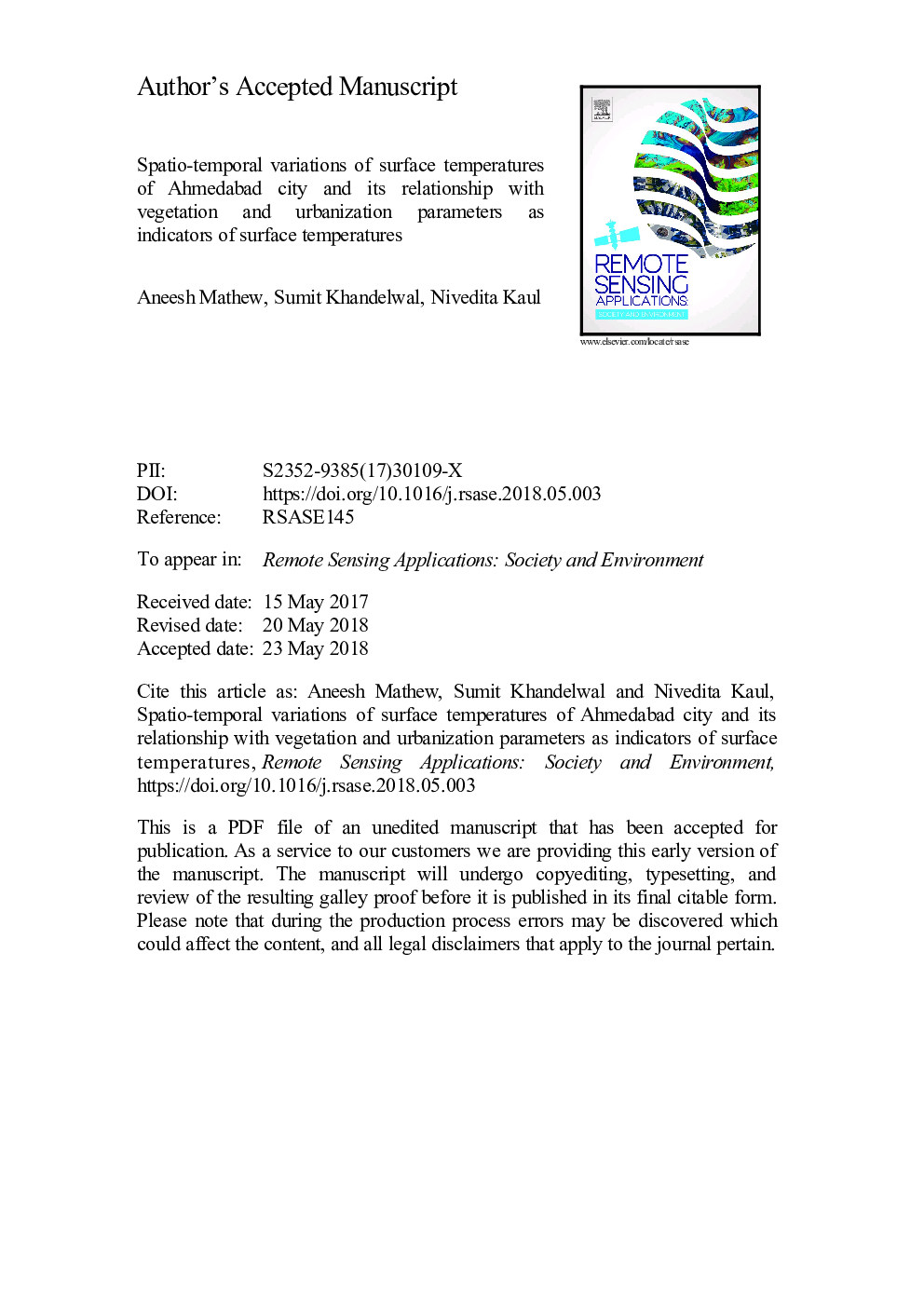| کد مقاله | کد نشریه | سال انتشار | مقاله انگلیسی | نسخه تمام متن |
|---|---|---|---|---|
| 8866307 | 1620996 | 2018 | 43 صفحه PDF | دانلود رایگان |
عنوان انگلیسی مقاله ISI
Spatio-temporal variations of surface temperatures of Ahmedabad city and its relationship with vegetation and urbanization parameters as indicators of surface temperatures
ترجمه فارسی عنوان
تغییرات فصلی و زمانی دما در سطح شهر احمدآباد و ارتباط آن با پارامترهای پوشش گیاهی و شهری به عنوان شاخص های دمای سطح
دانلود مقاله + سفارش ترجمه
دانلود مقاله ISI انگلیسی
رایگان برای ایرانیان
کلمات کلیدی
دمای سطح زمین، جزیره گرمایی شهری، شاخص رشد گیاهی شاخص نرمال سازی شده ساخته شده، درصد سطح غیر قابل نفوذ، تراکم جاده،
موضوعات مرتبط
مهندسی و علوم پایه
علوم زمین و سیارات
کامپیوتر در علوم زمین
چکیده انگلیسی
Land Surface Temperature (LST) has major importance in urban climatology, global climate change, and earth-atmosphere energy transfer. Relationship of vegetation and built-up parameters as indicators of LST has been investigated in the present study. The present study has been carried out to analyze the variations in rising in LST in the urban area than the neighboring rural area for three different seasons' winter, summer and monsoon of the years from 2009 to 2013 using Moderate Resolution Imaging Spectroradiometer (MODIS) sensor data. Analysis of 8-day night-time LST data shows that significant surface urban heat island (SUHI) exists over the Ahmedabad study area. Mean annual SUHI intensity from 2009 to 2013 varies from 6.01â¯K to 6.56â¯K, and overall mean SUHI intensity has been found out to be 6.17â¯K. SUHIindex has been used to compare the SUHI intensity of different periods and different seasons. The relationship of LST with normalized difference vegetation index (NDVI), enhanced vegetation index (EVI), road density (RD), normalized difference built-up index (NDBI) and percent impervious surface area (%ISA) has also been investigated in the present work. An inverse relationship has been observed between LST and vegetation indices (VIs) and it is season dependent. EVI has been used as a better vegetation parameter for SUHI studies than NDVI. %ISA has been reported to be a significant parameter for the analysis of SUHI effect and its relationship with LST has been found to be season independent. The relationship between %ISA and LST is similar for all three seasons with a consistent rising trend. A positive relationship has been observed between LST and NDBI especially for monsoon months. The trend of LST-NDBI relationship during different season is different, which indicates that the relationship between LST and NDBI is linear and is season dependent. It has been observed that soil and drier vegetation in rural areas show higher NDBI values. Hence NDBI cannot be used as a good indicator for SUHI studies. %ISA has been found to be a better parameter for SUHI studies compared to NDBI. Another parameter, RD, has been introduced in the present study to represent the extent of urbanization. A consistent positive relationship between RD and LST has been found for all the three study seasons of the entire study period, thus indicating seasonal independence of RD and LST relationship. Use of RD also considers the effect of anthropogenic heat, which is one of the main contributors to the SUHI effect, in addition to the effect of the impervious surfaces. Hence, RD is proposed as a suitable indicator for SUHI studies.
ناشر
Database: Elsevier - ScienceDirect (ساینس دایرکت)
Journal: Remote Sensing Applications: Society and Environment - Volume 11, August 2018, Pages 119-139
Journal: Remote Sensing Applications: Society and Environment - Volume 11, August 2018, Pages 119-139
نویسندگان
Aneesh Mathew, Sumit Khandelwal, Nivedita Kaul,
